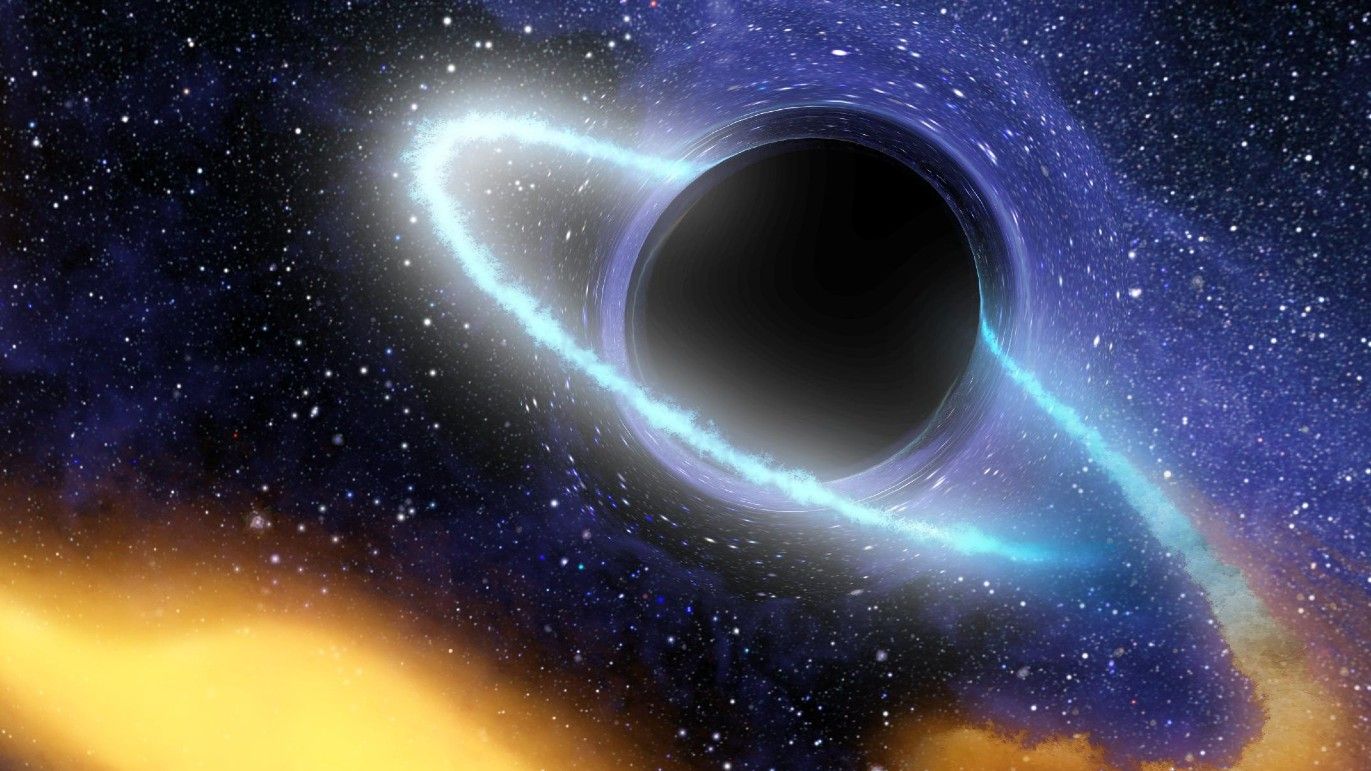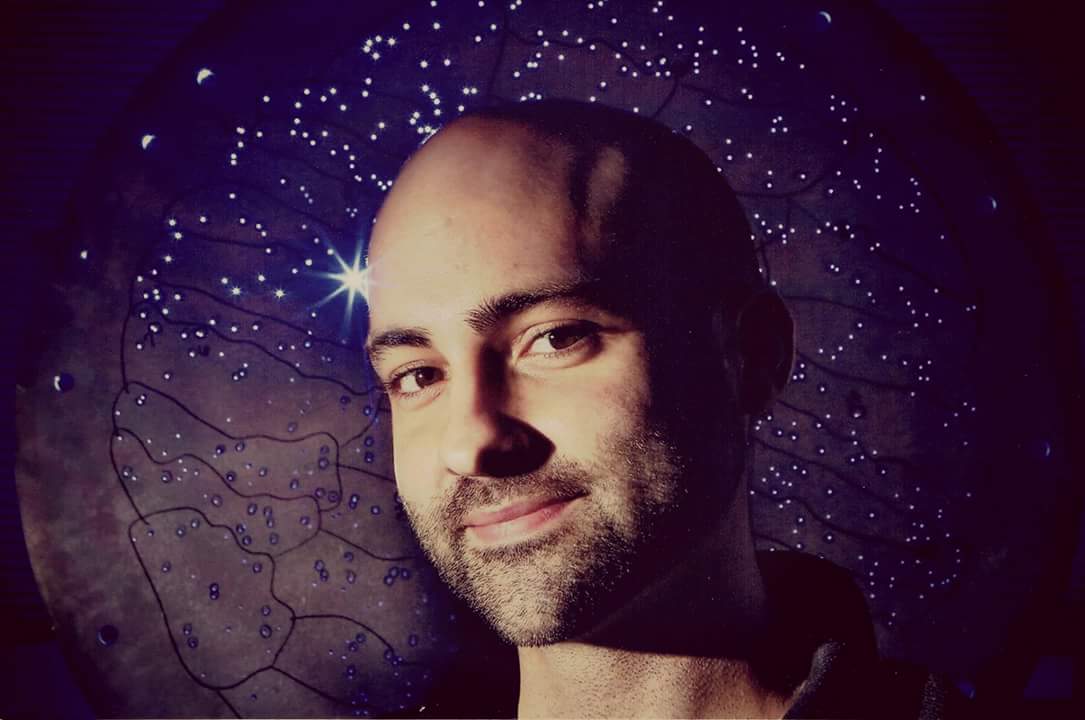What are boson stars — and what do they have to do with dark matter?
The skies may be full of invisible "boson stars."

Have you ever looked up at the night sky and wondered what you're not seeing? The skies may be full of invisible "boson stars" that are made of an exotic form of matter that does not shine.
We strongly suspect that the universe is full of dark matter, which makes up around 25% of all the mass and energy in the cosmos. But while circumstantial evidence abounds and we believe that dark matter is some sort of undiscovered particle, we don't have any direct evidence of such a particle.
For a couple of decades, we thought we were on the right track with a new kind of particle known as a weakly interacting massive particle (WIMP). Predicted from various supersymmetry theories, the WIMP would have a mass somewhere in the range of the heavier known particles, like the top quark. But otherwise, it would be largely invisible, interacting with normal matter only occasionally.
But searches for WIMPs have failed to find anything. That's fine; nature is never obliged to go along with our first guess. Thankfully, we have another particle candidate waiting in the wings: the axion.
The axion was introduced to solve a nasty problem involving the strong nuclear force. By all observations, the strong force obeys two important symmetries in nature: charge and parity. This means that if you take a strong force interaction, flip the charges of all the particles to their opposite values, and look at the reaction in the mirror, you'll get the same result.
But nothing in the theory itself says that it should obey these symmetries. Physicists attempted to fix this by essentially adding a new parameter to the equations and setting that parameter to zero, but that felt a little forced. Then came an ingenious solution: Maybe that new parameter represented a new quantum field, and interactions with that field naturally produced the symmetry.
This was the axion, so named after a brand of dishwashing detergent because it cleaned up the mess of the symmetry problem.
Get the Space.com Newsletter
Breaking space news, the latest updates on rocket launches, skywatching events and more!
If axions exist, they would make an excellent dark matter, because they would be abundant and hardly, if ever, interact with normal matter. And they would also do some wild things.
Axions are incredibly light — trillions upon trillions of times lighter than even the neutrino, the lightest known particle. With such slight masses, their quantum wave nature would manifest at macroscopic scales. While every particle also has a wave associated with it, we usually don't notice or care about those waves unless we're dealing with subatomic quantum systems. That's not so with the axion, which can potentially spread its wavelength across an entire galaxy.
The second cool thing about axions is that they are bosons. Bosons are a kind of particle that can all share the same quantum state, meaning you can stuff as many of them into a compact volume as you want. This is similar to photons (you can put as much light in a box as you want) and different from particles like electrons (you can only cram so many in before the box gets full).
These two properties of axions mean that they are exceptionally good at collapsing down to incredibly high densities, pulled together by their own (slight) gravity. Essentially, they can form a kind of star. It's completely invisible, radiates no light and does not interact with anything, but it's a star nonetheless.
These stars — which have a variety of names, including axion stars, boson stars and dark stars — can be small, roughly the same mass as normal, everyday stars. They can also be huge, spanning an entire galactic core.
The possible existence of boson stars is a double-edge sword. On one hand, it can make direct detection extremely difficult. Unless a boson star just happens to be wandering through our solar system and passing through Earth, we're unlikely to see axions in our detectors.
On the other hand, boson stars can do all sorts of things that could make them detectable, like mess with nuclear fusion in stellar cores or blow up on their own in an event known as a bosenova.
We don't know if axions exist or, if they do, if they're responsible for dark matter. But it's still fun to imagine a universe teeming with silent, invisible, harmless dark stars.
Join our Space Forums to keep talking space on the latest missions, night sky and more! And if you have a news tip, correction or comment, let us know at: community@space.com.

Paul M. Sutter is an astrophysicist at SUNY Stony Brook and the Flatiron Institute in New York City. Paul received his PhD in Physics from the University of Illinois at Urbana-Champaign in 2011, and spent three years at the Paris Institute of Astrophysics, followed by a research fellowship in Trieste, Italy, His research focuses on many diverse topics, from the emptiest regions of the universe to the earliest moments of the Big Bang to the hunt for the first stars. As an "Agent to the Stars," Paul has passionately engaged the public in science outreach for several years. He is the host of the popular "Ask a Spaceman!" podcast, author of "Your Place in the Universe" and "How to Die in Space" and he frequently appears on TV — including on The Weather Channel, for which he serves as Official Space Specialist.
-
Hildy Question - Just as the gravity of a normal star can affect the light from a star it passes in front of, would this also be true of a boson star?Reply -
Ryan F. Mercer Really Paul, again with the dark stars? Why do you want these so badly? Can't I interest you in a teapot?Reply
First of all, axion is about as stupid a name as charm quark. Yes, lets name it after a cleaning agent because it cleans up the problem. Why not name it money? Money cleans up problems too. For those that don't know, the charm quark solved the problem like a charm. Yes, I'm serious. Again, just plain stupid. So why I am going on about axions? Because the idiot that won the argument had a partner, and that partner had a really good idea. They said, "Hey, what if we called it Higglets, because of their relationship to the Higgs Boson", and also... piglets, because who doesn't like piglets? Clever, right? But also a wilting violet, because when said idiot decided their cleaning agent was somehow more clever, guess who won the argument? Now, I can't say I know the gender of those involved, but I have my suspicions.
Secondly, no. Just no. It's a fanciful meandering with no substance behind it. It's like looking for sasquatch. It only shows up in fuzzy imaginations. Stop it. Just stop it.
Third, Higglets! -
Ryan F. Mercer Replybillslugg said:All forms of matter and energy possess mass.
Photons have no mass. -
billslugg Reply
Photons have no rest mass, but all photons are moving .Ryan F. Mercer said:Photons have no mass.
All photons have mass as do all other forms of pure energy.
Matter has mass and energy has mass. Matter and energy can be transformed into each other, but the mass never goes away. -
Unclear Engineer I think the idea of a particle so light is mass that it has huge, macroscopic wave properties is worthy of consideration and exploration.Reply
That said, I think this story slides far down the slippery slope of "click bait' headlines and fanciful extrapolations.
First, why call something that does not emit photons a "star"? Especially if it does not supposedly involve some sort of fusion process? I guess "dark blob" doesn't sell the laundry detergents that sponsor such stories?
Further, why assume that nearly massless particles with huge wavelengths would tend to coalesce with themselves better than with regular matter? Why would they tend to congregate in volumes much much much smaller than their own wavelengths?
Because we are looking for a solution to the apparent existence of gravitational masses that are diffuse around galaxies, there does not seem to be any reason to hypothesize that they form "dark blobs" that are similar to other ideas such as rogue planets and failed stars of regular matter.
And worrying that such a "dark blob" might physically collide with Earth or something else in our solar system seems much less risky than the idea that it could gravitationally disturb Earth's or some other planet's orbit as it passes through the solar system. At least we would expect it to interact by gravitational attraction, even if it could pass through regular matter without any other sort of interaction.
For me, the idea of a sea of nearly massless particles that are bosons at cold temperatures raises the question about whether the galaxies are bathed in a Bose-Einstein condensate with quantum properties that exhibit effects at macroscopic, even interstellar or transgalactic dimensions. I think we would have a very hard time understanding cause/effect relationships for such circumstances, including effects like "negative time". "entanglement", etc. -
whoknows Replybillslugg said:Photons have no rest mass, but all photons are moving .
All photons have mass as do all other forms of pure energy.
Matter has mass and energy has mass. Matter and energy can be transformed into each other, but the mass never goes away.
With respect can you show where, and how photons, and any other forms of pure energy have mass? Not trying to be picky here, but this fundamentally goes against what I thought I knew - that being, roughly speaking, that mass is a condensation of energy. -
Unclear Engineer Whoknows, try this link: https://profoundphysics.com/if-photons-have-no-mass-how-can-they-have-momentum/Reply
Experimentally, we know that photons hitting the surface of a physical object transfer momentum to that object. From experiments, we know that the effective momentum of a photon is its energy divided by the speed of light.
How we think about that seems to be the real question.
If we assume that momentum is the product of velocity times mass, then we can derive an effective mass of a photon from its momentum, which we can derive from its energy, which we can measure.
But, from there, people go off into various theoretical directions about what mass really is. And that gets us into theories about an Higgs Field and Higgs Bosons creating mass by interactions with other "fields".
So, we seem to be able to show that photons act like they have an effective mass that comes only from their energy, but can then disagree about how that actually works. -
billslugg Reply
Matter and energy are two different form of mass.whoknows said:...mass is a condensation of energy.
Matter has mass and energy has mass.
Matter and energy are interchangeable forms of mass.









